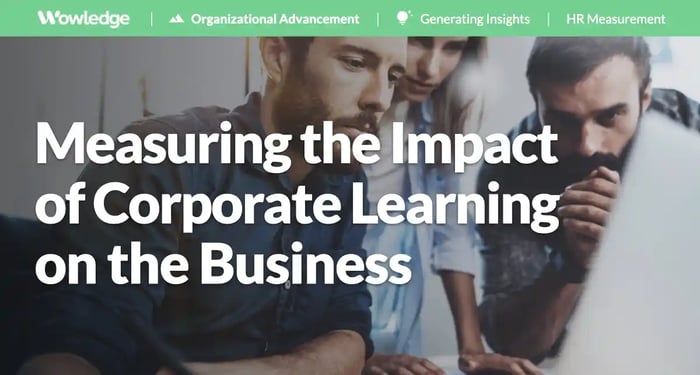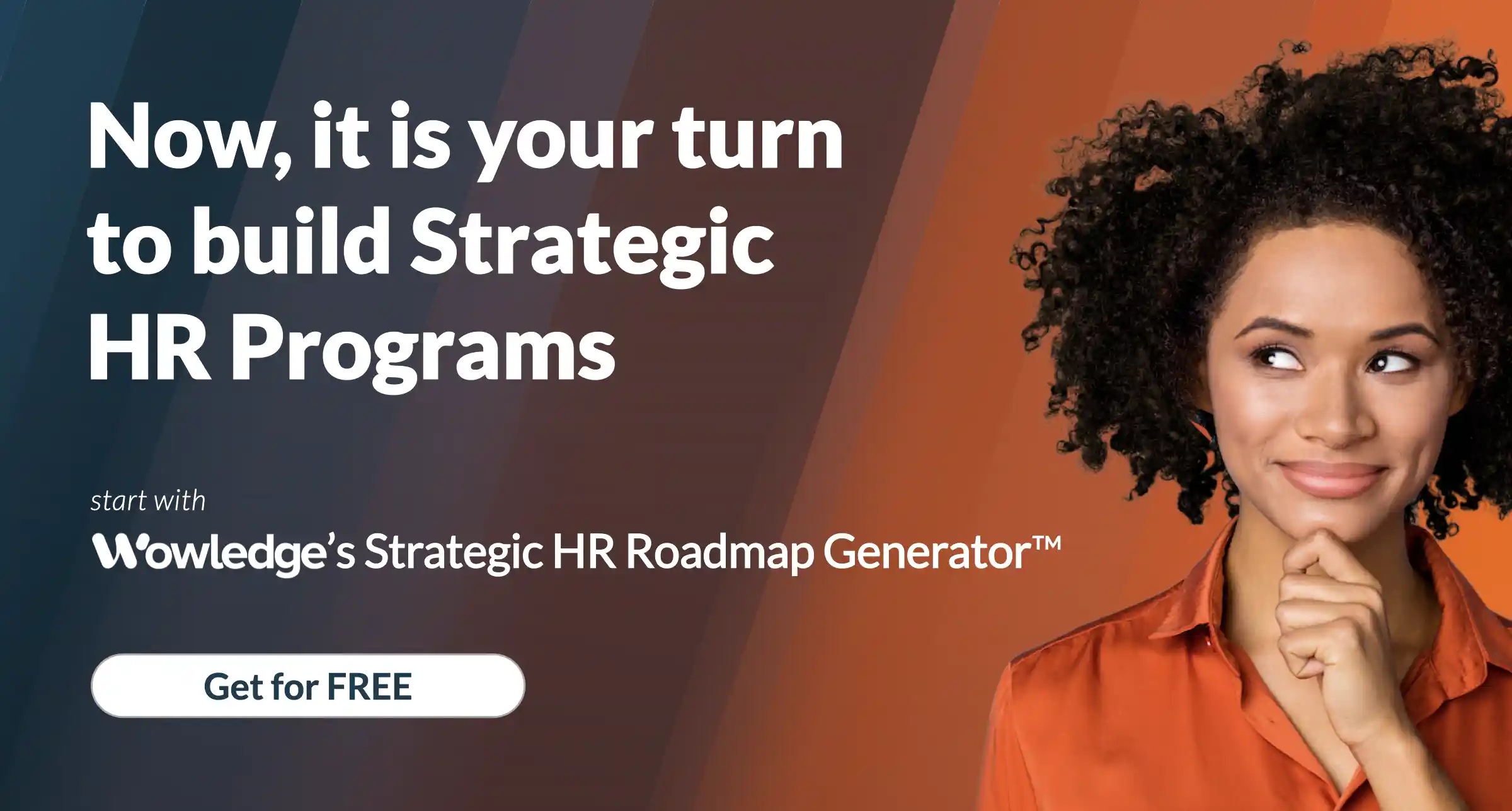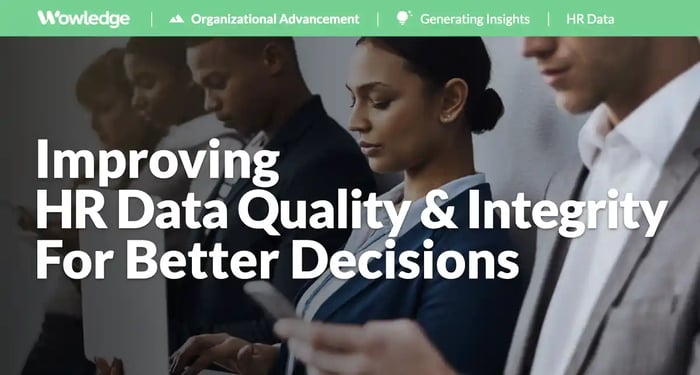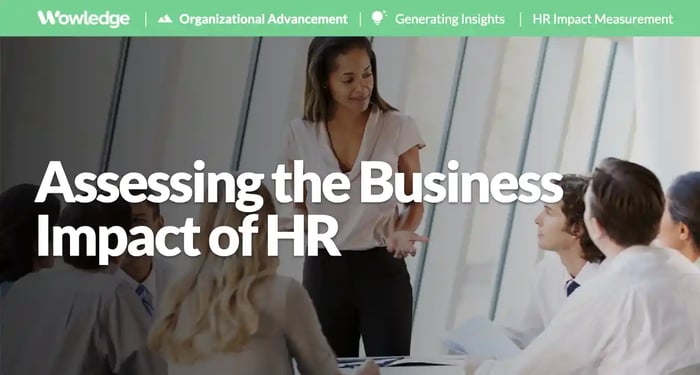Table of Contents
The use of analytics in HR is a powerful driver of significantly enhanced insights and decision support in the management of a workforce. It brings increased certainty when reviewing trends and occurrences, understanding employee behaviors and preferences, and assessing the effectiveness of HR processes, practices, processes, and programs. While certain HR functions are better developed in their use of metrics and analytics (e.g., recruiting, compensation, benefits), Learning and Development (L&D) lags despite business leaders’ thirst to understand the return on investment (ROI) from its programs and infrastructure. Measuring the impact of corporate learning is too often an elusive, yet continuing priority for many organizations.
A majority of organizations struggle with measuring the impact of corporate learning
While analytics across HR continue to be limited by some very common, yet resolvable challenges, L&D lags behind its peers despite representing a substantial and ongoing corporate expense. Consider that SHRM lists it as the third highest area of HR spend, trailing only recruiting and total rewards. That alone should provide sufficient motivation for quality measurement by the function.
The issues with measuring the impact of corporate learning are substantial, with the Association for Talent Development (ATD) reporting that 87% of organizations struggle to isolate the impact of their training. Brandon Hall Group reports that fewer than 16% of companies are capable of even identifying metrics related to the efficiency, effectiveness, talent, or business impact of any learning activity (formal or informal). Similarly, its earlier studies found that 60% of organizations are “not at all effective” at measuring informal learning, with 52% equally ineffective at measuring experiential learning activities.
D2L research found that 46% of L&D leaders called “demonstrating training effectiveness and impact” as their second biggest challenge, with 33% reporting “problems defining training evaluation metrics”. Even when measurement is in place, it is overwhelmingly focused on process and subjective criteria, which fail to address the business value of training and development design and delivery. For example, while 55% of surveyed learning leaders collected post-course opinions on the usefulness (to the current role) of the material learned, and 59% conducted post-training knowledge assessments, only 33% evaluated the ROI, and 42% assessed the financial impact on business goals or objectives.
Despite reports that proving the impact of corporate learning on business goals is a top priority for 77% of learning leaders, only 18% state that tracking the ROI of their programs is also a priority. However, at the same time, 57% do feel substantial pressure to objectively and measurably demonstrate that impact. So what is to be done, and how can learning leaders approach measuring the impact of corporate learning?
Common challenges faced when measuring L&D impact
Awareness of the issues that hold L&D teams back from measuring the impact of corporate learning and development programs serves to assure those experiencing these that they a) are not alone, and b) these can be overcome with solid planning and execution.
Lack of analytics expertise
A common issue across HR functions, this is especially problematic for learning teams. The proficiency of team members skews more towards instructional design, adaptability, communication, project management, collaboration, innovative thinking, and the design and implementation of learning strategies and technologies. Expertise as data-focused, statistically capable, and analytically advanced professionals is much less common. In fact, research by ATD found that only 46% of organizations provided data literacy learning opportunities for employees, and just 51% offered data analysis training.
Overreliance on participant evaluations
Tried-and-true learning measurement continues to dominate, with “smile sheets” asking employee opinions and insights into the quality, length, and applicability of learning content as the primary measure of success. ATD found that even with those, 73% of organizations complained that learning program participants failed to respond to requests to provide evaluation data. And with so many employees participating in informal learning, most organizations are unable to capture any insights into that activity, much less its perceived or real value to the knowledge and skills of employees.
Data and analytics infrastructure
Persistent issues with a lack of integration of multiple HR and business systems and data repositories, along with associated difficulties with data quality and integrity challenging for L&D teams. ATD reports that 82% of companies have training data that is isolated from other data, and 75% state that they do not have access to the data they need to conduct even high-level analysis.
Resource constraints
As HR teams in general face budget constraints and staffing reductions, the availability of staff, tools, and technologies continues to be a barrier to advancing in the measurement arena. When the business and operationally critical upskilling and reskilling of employees dominates the L&D agenda, providing access to quality learning content is prioritized over many of what are viewed as “nice to have” capabilities, such as measuring the impact of corporate learning.

What it is: Measuring the impact of corporate learning
Getting a clear grasp of what goes into measuring the impact of L&D programs and processes is an essential step for learning leaders. Much like any other HR analytics effort, there needs to be a common understanding of the elements of Learning and Development processes and offerings that can be leveraged when developing an impact measurement approach. Defining these critical elements is only an initial step in defining the impact of learning on critical operational objectives. The data to be collected for subsequent impact analysis can be separated into two categories – activities and outcomes.
Learning activities
A learning activity is any behavior or action taken by an employee to increase their knowledge or acquire and refine their work skills. These represent steps that are taken by the workforce to select and participate in available learning and development resources and activities. They are the most commonly measured elements of a training and development process, and include actions such as enrollment, attendance or utilization, completion, and evaluation. Often reported as outcomes, they are also aggregated or calculated to produce measures of participation volume, workforce penetration, starts vs. completions, learner satisfaction, utility, and net promoter score (NPS).
These are widely dismissed as overused, overly simplistic, inwardly-focused, and meaningless as business-focused KPIs. However, they do have some value for the L&D team, with a larger and more significant role as a starting point for more advanced analyses and business impact KPIs. Consider their value in developing an understanding:
- What top performers in a role rely upon to develop and refine their knowledge and skills.
- The L&D activities that are significant predictive elements of future success, when put into a statistical model with other factors (e.g., psychometric, demographic, educational, experiential, role and responsibility, career path) to objectively understand the relative effect of learning on continuous high performance, potential that turns into advancement, longer-term retention, higher pay and bonuses, etc.
What this means is that activity tracking is valued when it is used in subsequent analyses that generate insights into talent outcomes such as high performance, promotability, and retention, which in turn can be leveraged into analyses of learning activities that contribute to generating increased business impact of corporate learning.
Talent outcomes
One of two types of outcomes that define the second key element, talent outcomes refer to the measurement of the critical and desirable results of any learning and development activity. Consider the purpose of offering a live or virtual course, an eLearning module, a book or speaker, a coaching or mentorship relationship, a peer collaboration platform, or access to a searchable knowledge management system. Those require a specific purpose and reason for existence—meaning the acquisition or enhancement of specific knowledge, skill, or capability associated with a higher level of (current) job performance, preparation for a (future) successively higher or different role, or adaptation to new advances or strategic directions.
The measurement of talent outcomes involves assessing three primary goals (with examples of data collection methods):
a. Knowledge retention and application
This is the evaluation of the extent to which the content in the activity was retained and can be fed back. The data can be collected immediately upon completion of the learning program or activity, shortly thereafter, or later on after the opportunity to apply it has been experienced. Examples of assessment methods that generate the data include:
- Post-course or activity testing
- Demonstrated ability to explain, present, or teach to others
- Ratings of subsequent application and performance on trained material
b. Skill acquisition and growth
The assessment of how well a new skill has been learned and can be applied on the job, including capability mastery or improvement. This represents an essential characteristic of robust learning measurement, which is the extent to which a skill developed in a controlled setting can be applied on the job. These are valued because they are often the precursors of high performance and contribution, as they show up in how the work is conducted, how the employee collaborates and communicates, and how efficiently they are able to perform their tasks. Methods of evaluation include:
- Expert-observed role plays, case studies, and on-the-job observations
- Manager, team, or peer observations and feedback
- 360-degree or direct observation of changes and improvements in targeted work behaviors
c. Individual performance
These are often the most visible, valuable, and credible criteria of talent outcomes—the extent to which newly learned information or acquired skills have a noticeable impact on individual targets and goals. Performance improvement and the ability to generate outputs at higher volumes, with greater efficiency and speed, and higher quality, while creating enhanced approaches and methods, are all measurable. Examples of methods for evaluating these quantitatively include:
- Sales or output volume, customer satisfaction ratings, error rates, productivity, speed to completion, or project completion (vs. schedule, deliverable expectations).
- Performance appraisal grades, competency ratings, and stack rankings relative to peers.
Other critical talent outcome metrics include employee productivity, turnover, engagement, employee and learner experience, and absenteeism.
Business outcomes
The second major outcome to measure, and the most valued, is the business outcome. It is essential to understand at this juncture that talent and business outcomes will be included in the analyses of learning activities and their impact on both. Business impact measurement is considered by many to be the ultimate goal of robust HR analytics. However, it is truly just a starting point. The promise of analytic approaches in HR is broader than demonstrating business impact, as the early identification of talent trends, risks, and opportunities that HR can use to influence and impact business success is even more powerful. Business measures and methods that can be used for analytical purposes include:
- Sales, revenue growth, net income, profit margin (gross and net), return on investment, market share.
- Customer satisfaction, returns, churn, retention rate, customer acquisition cost, net promoter score, conversion, and repeat purchase rates.

A pathway to measuring the impact of corporate learning
Establishing a solid approach and methodology for identifying, assessing, tracking, and communicating the impact of learning and development activities on critical talent and business outcomes is a journey, not a destination. It is a step-by-step process to start, followed by ongoing review and growth of the capability. The key is to prioritize what metrics and analyses are needed to start, and then advance towards more meaningful ones as the organization becomes more comfortable and the necessary resources are available. Start by chartering a cross-functional project team with expertise in learning strategies, data and analytics, and IT to develop the analytic approach and methodologies.
1. Identify talent and business priorities
Trying to measure the impact of every learning program (and module, chunk, or snippet) and development activity will immediately overwhelm the team. The best approach is to start small, learn what is needed and what works best, and deliver something meaningful and of value. That requires prioritizing the most crucial learning based on business objectives. Consult the strategic plan or top executives to identify the most pressing needs – be it revenue growth, leadership skill enhancement, or customer retention- and identify the programming that is directed towards those. An alternative is targeting a critical workforce segment (CWS), which has a disproportionate impact on the achievement of strategic objectives. Either way, start with a pilot project to establish a methodology and engage experts from L&D, IT, Finance, and, if needed, analytics.
2. Catalog learning objectives
A crucial step is to define what needs to be measured, to clarify the alignment between the program or activity and the priorities. Review and document the learning objectives of the targeted programs or activities, whether by course, module, or activity.
3. Determine the learning-to-business value chain
Apply the logic of balanced HR scorecard strategy map to define the impact of the learning on the business (in the future, these relationships can be calculated statistically). That approach has the team considering four successive questions:
- What skills or knowledge does the L&D program or activity produce?
- …That affects the performance of which internal business processes?
- …Which in turn influences which customer or supplier outcomes?
- …And that impacts which business or financial returns?
An alternative is to build a learning “logic bridge” that might be easier for the team to digest and conduct:
- In this program, learners will learn [this].
- Because they know this, they will be able to do [this].
- Because they do this, they will perform [in this way], and produce [what output] better.
- The aggregate effect of this improved performance on [this key business objective] will be [this].
The goal is to articulate how the learning will advance a specified business or operational priority in a quantitative way. The next step informs how to quantify that relationship.
4. Measure the learning and outcomes
Collecting the data that is available for measuring the impact of corporate learning may be (as discussed above) a challenge, but when starting on a pilot basis, it should be easier and less complex. It requires access to data from the learning technologies, HR or talent management systems, and business management (e.g., ERP, finance, sales) systems. From each of these, data that the project team will find relevant data to choose from, including:
- Learning activities: Select targeted learning activity data from the relevant learning technologies to assess and understand where the employees turn to acquire knowledge and develop skills, such as a learning management system (LMS), a learning experience platform (LXP), or a knowledge management (KM) platform. These will be sources that track formal learning attended or accessed, including live and virtual courses, and eLearning offerings. Similarly, measuring informal learning, which is spontaneous or unplanned, search-based, interpersonal, or embedded in work systems that are related to the learning objective, can be tracked and assessed. Pull data from collaboration platforms (e.g., Slack, Trello, Google Workspace, MS Teams, Github), knowledge management systems, registration systems for virtual meetings and presentation platforms, as well as any system that collects data on employee attendance at external conferences or workshops.
- HR or Talent Management data: The use of data captured and residing in HR information systems (HRIS) or talent management systems (TMS) can become a valuable source of talent outcome data. Data should be considered related to assessed performance levels, tenure, promotions, merit increases, skills and proficiency levels, competency ratings, innovation achievements, and other talent outcomes associated with business objectives. In addition, experiential learning data related to coaching, mentoring, special projects, or rotational assignments can be captured in performance management systems or modules from HRIS and TMS.
- Learning-targeted business or operational outcomes: The outcomes that matter most are those that define business success. Including a project team member from finance and IT can enable access and permission to use business outcome data of a financial and operational nature. Consider outcomes identified in the value chain analysis related to revenue (sales and sales growth %, revenue per employee, sales per channel/business unit/market), profitability, market share, and other key financial outcomes. In addition, those related to manufacturing processes and outcomes (production levels, time-to-market, error or return rates), and service delivery can be used to great effect.
5. Perform impact analyses
The final step is to conduct the analysis of the level of impact that learning activities have on specified business outcomes. The key is to assess the impact of the learning activity(s) on the outcomes that matter most to business leaders. Measuring the impact of corporate learning through these examples of meaningful analyses provides a window into the possibilities that can shed light on the relative value of L&D programming.
The analyses are based on statistical relationship testing using correlational or regression testing. These involve comparing groups – the performance of the “experimental” group (individuals or teams who completed the course(s) or activity(s) versus that of the “control” (untrained) group, and the relative effect that each had on the organization’s level of business achievement (sales, revenue, profit). Examples of these include the impact of individual learning courses, certification & educational programs, or learning objects.
The impact of learning on subsequent talent outcomes on:
- Individual job performance.
- Performance by job family, role level, or corporate function.
- Skill acquisition or proficiency enhancement.
- Demonstration of targeted work capabilities or behaviors (collaboration, problem solving, customer service, people management).
- Employee engagement, high performer retention, employee mobility.
The impact of learning on targeted business outcomes on:
- Team (department, project) or function (manufacturing, distribution, sales, marketing), production, revenue generation, customer loyalty, quality, cost.
- Business unit, geographic market, or facility output, profitability, revenue growth, revenue per customer, repeat purchase rates.
- Enterprise customer satisfaction, profitability, market share, productivity, innovation, speed to market.
Relevant Practices & Tools
Emerging HR Metrics and Reporting Practices to Drive Situation Assessment and Actionable Insights for Managers and Leaders. >
HR Metrics & Reporting is a standardized and structured experience for both developers and users of the data and reports... more »
Developing a Learning Measurement Process to Monitor Progress, Results, and Communicate Value. >
As HR and L&D are essential business functions, evaluating the outcomes of learning programs is crucial for justifying their continued existence and use, and is also vital for monitoring and communicating their success... more »
Defining Learning Requirements to Clarify Purpose and Desired Outcomes. >
Building a learning and development capability requires an understanding of the organization’s direction and strategies, how these translate into learning requirements, and the present and near-future learning needs at the functional level (e.g., operations, sales) for employees... more »
Conducting Workforce Segmentation to Focus on the Most Valued Positions. >
Workforce Segmentation describes the process of categorizing roles in the organization and determining the value of each relative to the strategic objectives of the company... more »
The Process to Outcomes Translation Tool: Convert HR Strategies and Processes into Representative Metrics. >
The Process to Outcomes Translation tool is designed as a guide to creating metrics that represent HR's impact on the business... more »
About Wowledge
Wowledge is the implementation-first platform designed for lean HR teams and consultants who need to design and scale strategic HR programs efficiently—without starting from scratch.
Our members gain access to continuously updated best practices, step-by-step guidance, expert-built tools, and customizable templates—all structured to accelerate the development and implementation of key HR programs.
Recognizing that every organization operates at different levels of sophistication, Wowledge’s scalable system of best practices follows a stage-based approach—Core, Advanced, and Emerging—ensuring HR professionals can implement solutions tailored to their organization’s unique needs and goals.
Your Shortcut to Amplifying HR Impact!
Get started for FREE! Learn more.










